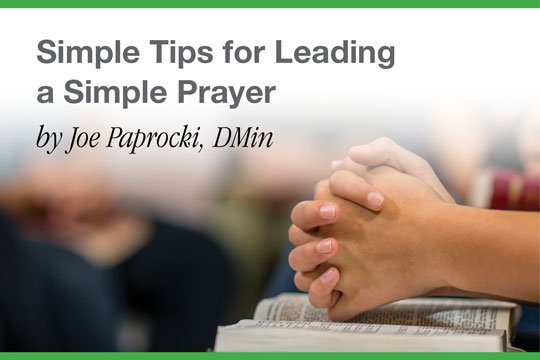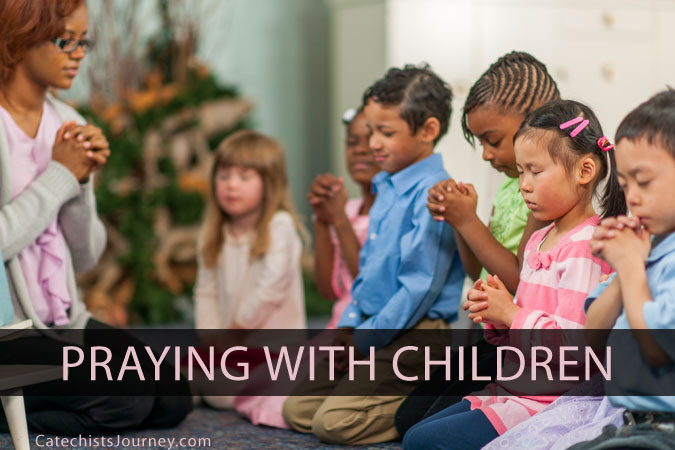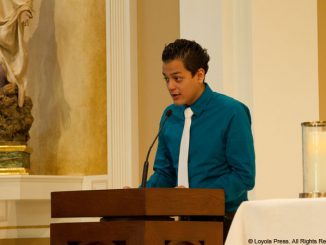This is the second article in a series about leading prayer.

Whenever Catholics pray before group activities—whether a staff, catechist, or parent meeting or a gathering of the parish youth group—we offer all our efforts to the Father. We acknowledge that when we are gathered, Jesus is present with us. We invoke the Holy Spirit to guide us. Group prayers sanctify the activity, reminding us that the ultimate goal is to glorify God.
Yet how many times have we experienced group prayer that seems rushed or perfunctory? Sincere, but stale? I have attended far too many meetings where the opening prayer consisted of a quick Hail Mary, a poem, a recorded song, or a canned prayer service where people take turns reading from a sheet of paper. Yes, we prayed. But was it a good prayer? Or was it simply an obligation we rushed through to get down to the real agenda?
How we pray at our group meetings says a lot about our faith. Because it reflects what we believe about God, prayer can either form or “de-form” people. If we believe that God is present, powerful, and active in all we do, we need to show it.
Prayer is part of the agenda of any meeting, and it requires our full attention. However, many people are uncomfortable in leading group prayer. They simply aren’t sure how they should model prayers for the meeting. The best course is to look to the public prayers of the Church: the Liturgy of the Word and the Liturgy of the Hours. By imitating them instead of your personal, devotional, or conversational prayer, you will more effectively call people’s minds to God’s presence in your midst.
While most people remember to begin a group prayer with a prayer such as the Sign of the Cross, after that, they don’t know what to do. However, leading a group prayer can be simple and authentic by following this easy formula: You, Who, Do, Through.
- You: Gather in an environment reflecting the current season of the Church Year and pray the Sign of the Cross.
- Who: Address God directly, expressing gratitude for the ways God shows his love.
- Do: Ask for God’s presence and action in the gathering.
- Through: Close the prayer in the name of Jesus.
You may also want to incorporate other practices if you want a more elaborate group prayer:
- Employ verbal formulas from the Mass to help people know how to respond. They won’t need handouts to guide them.
- Use Scripture. You may include a short Gospel reading followed by a moment of silent reflection, or you might want to pray the Scripture using lectio divina.
- Invite participants to pray for their needs and the needs of their loved ones. These intercessory prayers can follow the Prayers of the Faithful from the Mass, where each petition ends with, “We pray to the Lord,” and the response, “Lord, hear our prayer.”
- Incorporate music, poetry, and art to enrich the prayer. By themselves, however, they are not prayer.
- Conclude with a prayer everyone knows, such as the Lord’s Prayer, Glory Be, or Hail Mary. This is the best way to make sure everyone has a part.
Prayers that resemble our liturgy help reaffirm our Catholic identity. They are deep, rich, and naturally participatory. Most importantly, prayers that resemble our liturgy will draw our minds toward the Mass, reaffirming the Eucharist as the source and summit of our faith.
Whenever we gather in Jesus’ name, he is present. We must ensure that our group prayers call the presence of God into our gathering so that we may achieve more in his name. After all, everything we do is to bring God glory.
Read the first article in the series: Setting the Stage: Creating the Space for Prayer.





In our diocesan department we have set a goal of “tithing” 10% of our meeting time to prayer. This has helped us to be more intentional and deliberate in our prayer together and with others.
What a wonderful idea. “Tithing” prayer time seems to be phenomenal idea.